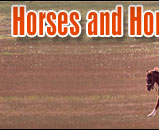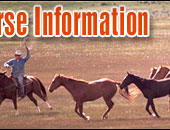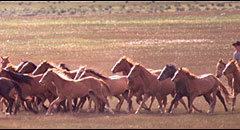 |
   |
|
|
|
You are here: Horses > Horse nutrition / feed > Equine Treats |
Healthy Horse Treats:
Be Aware of Ingredients and the Safety of Your Equine’s Health
Most animal trainers, whether they work with dogs and cats
or lions and monkeys, use some form of a food treat as a
reward. Snacks and treats for horses are becoming almost as
popular as dog bones and catnip, with more companies than
ever putting out products to delight the horse’s taste-buds.
Most people who are accustomed to buying goodies for their
dogs and cats are starting to do the same for their horses,
using treats as a reward for learning a new trick or skill,
or to tempt a reluctant animal to come closer. |
|
|
However, one doesn’t have to buy a specially formulated
horse snack to give treats. A good treat is anything that
the horse enjoys, from those scientifically formulated and
nutritionally-balanced nuggets to a carrot stick. Even if
the horse simply enjoys its regular grain, it can be given
as a treat. What makes it a reward is the way that it is
given, usually by hand, and that it’s offered outside of
regular feeding times. |
Feed stores now often have shelves set aside just for horse
treats. From handmade horse candies and biscuits and
manufactured vegetable-flavored nuggets to old-fashioned
sugar cubes and grain cubes, there is a wide selection to
choose from. Commonly, horse treats contain oats, hay, bran,
a sweetener such as sugar, sucrose, or molasses, and some
kind of flavoring. Read the treat’s nutritional label and
try to find a tasty treat that is not too nutritionally
different from your horse’s regular diet. This will make
sure that the treat doesn’t upset the horse’s delicate
digestive system.
Treats should be given sparingly to prevent upset to the
horse’s digestion. One ounce daily is usually a good amount
that won’t cause problems. However, for owners who tend to
give more than this, selecting a horse treat with good
nutritional value, as well as being firm about only giving a
certain amount of treats daily, is the best way to avoid
gastric upset. Treats that contain hay and grain products as
the first ingredients on the list are safest for owners who
might go overboard on treats.
Other tips for safely giving your horse treats are:
- Discuss your horse’s diet with a nutritionist or your
veterinarian to make sure your horse is getting all the
nutrition it needs. Then you can safely give your horse
treats. Two to four ounces of snacks a day is more than
sufficient, because giving too many treats can interfere
with normal grazing and meals and cause weight gain or
gastric upset.
- Remember, treats are not supplements. They are not
part of the horse’s daily ration. Supplements provide a
necessary, daily source of nutrients. If the horse’s
treats are discontinued, it shouldn’t cause any deficiency
in the horse’s diet. Supplements, while occasionally very
tasty, should not be used as treats, because overuse of
these can cause toxicity or gastric disturbances.
- Read the list of ingredients and choose a treat that
contains ingredients that are in your horse’s normal feed.
This is especially helpful for picky or colic-prone
animals.
- Give treats sparingly and at different times. Some
horses can become aggressive if they are not given a treat
at the habitual time, or can nose at jacket pockets
searching for a treat. Some will even bite if they don’t
receive the treat! Also, give treats one-on-one. Horses
can get excited and aggressive if they feel they must
compete for treats.
- Horses have a blind spot just in front of their noses.
Keep this in mind when selecting treats. Chose one that is
large enough for the horse to lip from your hand to
prevent nipped fingers. If offering a treat to a strange
horse, it is safest to offer it from a bucket or place it
in the feeding trough.
- Treats should be firm enough not to crumble, but not
so hard that they are difficult to chew.
- Avoid storing treats in containers that can be easily
tipped over, are not water--tight, or can be chewed.
Flat-bottomed, re-closable, rodent-proof containers are
best to prevent contamination.
- Finally, treats do not have to come from the feed
store. Apples, carrots, or even handfuls of grass can be
great rewards. Just remember, as with manufactured treats,
not to overfeed.

|
Read the next horse nutrition article on
Checkoff Programs for Horse Feeds. |
|
|
|
|
 |
|
|
 |
 |
  
Visit Equestrian Cupid now.
The best and largest equestrian club for meeting the other half for friendship and marriage
|
|
 |
|
|
|
Horse Education
|
|
|
|
|
Horse Information Topics
|
|
|
|
|
|
|
|
Horse Business Owners
|
| |
Advertise with Us
Have your horse products or services exposed to over 27,000 of our monthly visitors.
|
|
|
|
|
|